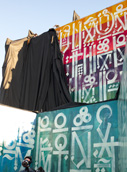Sept. 21 Update: Since the art panels have been removed and the house is in compliance, the City of Santa Monica will not charge Corlin with any fines.
Sept. 20 Update: Adam Corlin and 15 volunteers removed the art panels the morning of Monday, Sept. 19. We at Heal the Bay extend a heartfelt thank you to Corlin, RISK and Retna for their creativity, hard work, perserverance and commitment to our oceans.
Update, as of Sept. 14: Corlin announced today that he will remove the artwork on Monday, Sept. 19 at 8 a.m. If you’re interested in viewing the mural, please plan your weekend accordingly.
Update: On Thursday Corlin was informed that city of Santa Monica officials had ordered the “immediate removal of the panels.” Corlin, who may possibly face a fine of up to $5000 a day if he does not comply, and the artists are urging the public to call Santa Monica City Hall at 310.458.8201 to keep the project in its original location. Read more.
“Oceans at Risk” is a labor of love for Adam Corlin, a longtime Heal the Bay volunteer and homebuilder. His dream to help protect the world’s seas began when he bought a dilapidated house in northeast Santa Monica, covered with graffiti and plywood and occupied by squatters. Others saw an eyesore, but Corlin saw a “big billboard” that could use street art to raise worldwide awareness about a deeply felt cause.
He knew he could rehabilitate the rundown site, but he knew it could be so much more than just another development project. “I wanted to send a message,” Corlin says.
After months of stealth art-making by L.A. street artists Risk and Retna, the message will be unveiled Thursday morning: “Restore and protect the world’s oceans.”
The art project is composed of 150 wood panels hung on the scaffolding around the frame of an under-construction three-story house, at 825 Berkeley Street, which sits on a bluff with views of the Pacific Ocean. It’s taken two months and the hard work of dozens of committed craftsmen and laborers, who worked long, hot hours hidden beneath plastic sheeting and tarps.
Imagine pulling off that big of a project. Now imagine pulling it off in secret.
No one in the neighborhood even knew there was an enormous art installation taking place until it was done. As Corlin announced on Twitter before the unveiling: “We are about to pull off the biggest Art Heist in History. Okay, it’s just the Biggest Art Event of the Year!”
Risk, who went to University High School on the Westside, joined the project through a landscaper friend of Corlin’s, and Retna soon followed.
“Street artists use their art to express how they feel. The ocean and the animals who live there don’t have a voice,” Corlin says. “It’s a wonderful thing that these guys from the street are using their talents to speak for a cause that can’t speak for itself.”
The world’s seas are hurting, be it from plastic pollution, overfishing or global warming. But it’s not too late to change our ways. So, rethink your consumption habits — (skip the plastic and watch the fertilizers!). Keep trash off the streets. Donate to your favorite ocean-related nonprofit. Call your legislators and tell them to make ocean protection a priority.
“This is a global project,” Corlin says. “On Sept. 17, Coastal Cleanup Day will span 65 countries. It’s one of the largest volunteer projects in the world because it’s going to take everybody to bring awareness to what’s going on in the world with our oceans.”
Read more at the LA Weekly.



